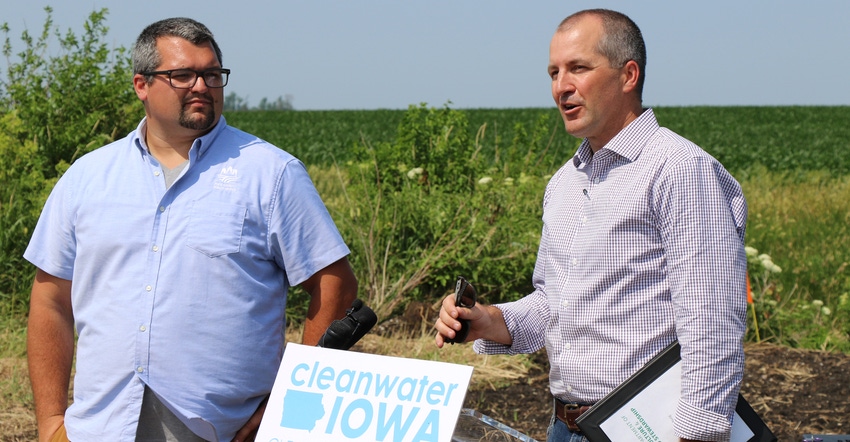July 1, 2021

Iowa Secretary of Agriculture Mike Naig recently joined state and federal government agencies, Polk County officials, conservation contractors and local landowners to kick off the Central Iowa Water Quality Infrastructure Project. The unique water quality project creates a new framework to streamline and scale up adoption of saturated buffers and denitrifying bioreactors in Polk and Dallas counties by making the financing and construction processes simpler for landowners.
At Kurt Lehman's farm near Alleman, Iowa, Naig thanked the project partners who helped design, build, fund and recruit landowners for the project. He also thanked the participating landowners for being conservation leaders.
"This project creates a model that allows us to speed up the pace at which we're adding more soil health and water quality practices. These practices directly benefit the residents of Polk and Dallas counties and our neighbors downstream," Naig said. "Other communities are watching what's happening here. We know that success here will lead to successful projects in other priority watersheds around the state."
Johnathon Swanson, watershed management authority coordinator with Polk County Public Works, calls the streamlining of financing and construction a "fiscal agent" model that gives contractors access to sites through a temporary construction easement. "The easement allows contractors to access private lands, and ensure the landowners and funding agencies' expectations are met," he said. "The easement payment to the landowner incentivized participation and helped generate interest in the project."
Construction contractors broke ground on Phase 1 of the project in June, which is scheduled to take about a year to complete. Crews are installing 40 saturated buffers and 11 bioreactors on the edge of farm fields to help protect water quality and support recreational opportunities in the Des Moines and Raccoon rivers.
Phase 2 of the project is expected to include another 150 sites and additional counties and partners moving forward.
Conservation practices at work
Saturated buffers have underground lateral pipes that divert tile-drained water through a vegetative buffer. The vegetative buffer removes sediment, phosphorus and pesticide runoff, while creating wildlife habitat.
Bioreactors are excavated pits filled with wood chips that filter tile drainage water. As water from the tile line passes through the wood chips, denitrifying bacteria converts nitrates in the tile water into di-nitrogen gas.
Locating sites
Swanson said sites were selected using mapping tools that consider topography, stream bank height and soil types to identify project sites that will have the greatest impact on water quality.
From there, organizers reached out to farmers and landowners living along Fourmile, Mud, Camp, Spring and Walnut creeks to encourage them to get involved.
"Identifying multiple sites in one county made it easier and more attractive for contractors to bid on the project," Swanson said, "which reduced the overall project costs."
Project partners
The Central Iowa Water Quality Infrastructure Project was formed through strong collaboration among the following entities:
• Polk Soil and Water Conservation District
• Polk County
• Iowa Department of Agriculture and Land Stewardship
• USDA Natural Resources Conservation Service
• Agricultural Drainage Management Coalition
For more information about the project, visit cleanwateriowa.org/centraliowaproject.
Sources: Iowa Department of Agriculture and Land Stewardship, Iowa NRCS, which are responsible for the information provided and is wholly owned by the source. Informa Business Media and its subsidiaries aren't responsible for any of the content contained in this information asset.
You May Also Like




